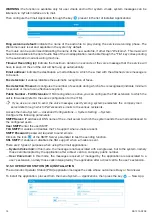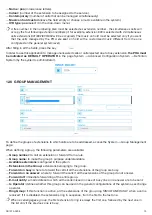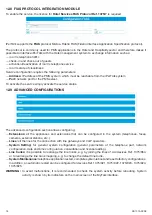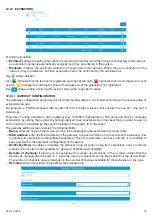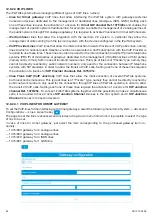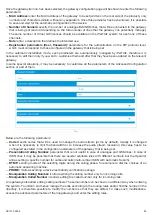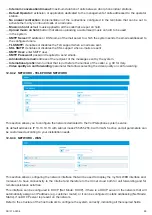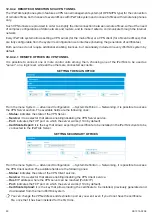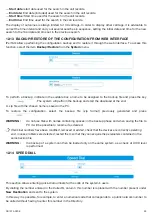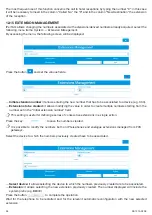
87
DS1375-020E
—
Activate Registration:
timeout for the registration of your own credentials on the Provider’s servers. The
registration activity (namely the authentication) performed from the iPerTAlk system towards the VoIP Provider
is used to communicate on which public IP/port the calls from public numbers will be sent, in order to allow
managing by the iPerTAlk system. Therefore, if the public IP is static and the connection to the Internet network
is stable (i.e.: not subject to frequent interruptions), it will be possible to set the longest time interval among
those available.
In the section “Advanced Configuration” there are further parameters:
—
STUN:
it enables the STUN service for the resolution of the Public IP (to be enabled MANDATORILY if the
gateway is referred to an Internet service provider).
—
DTMF:
defines the mode for sending DTMF digits during the call (check the supported mode with the Provider).
—
Root Number:
telephone/user number assigned by the Provider.
—
Probe:
it allows sending an active line verification package.
—
Transport Protocol:
protocol for SIP signalling (check with the Provider).
—
Manipulation Calling Number:
it modifies the calling number of the incoming calls from the Provider (used to
remove international area codes or other) from the inbound calling numbers.
—
Manipulation Called Number:
it modifies the calling number of the incoming calls from the Provider (used to
remove international area codes or other) from the inbound calling numbers.
—
Reg. Parameters:
username and password used for registration.
12.9.2.3.4 TRUNK LINES (VOIP JUNCTION)
To set VoIP Junction lines, select the following menu items: System
→
Advanced Configurations
→
Lines, press
the key
.
The page to set the lines is accessed and includes a drop-down menu from which it is possible to select the type
of line to be set, in this case
VoIP Junction.
Indicate the following parameters:
—
Name of VoIP Junction:
displayed name that allows identifying the lines being created.
—
Remote PBX Address:
indicate the IP address of the iPerTAlk Remote system to which you are connecting.
If the two systems can be reached in the local network, enter the local IP address of the telephone line,
otherwise indicate the public IP address (or the relevant DNS name) or, alternatively, the IP address of the VPN
shown in the relevant section of the main page.
—
Port of the Remote PBX:
indicate the port of the SIP protocol (5060 by default) set for the Remote system.
—
System Address:
indicate the IP address of the iPerTAlk server or the local address (namely the one that is
being configured). If the two systems can be reached in the local network, enter the local IP address of the
telephone line, otherwise indicate the public IP address (or the relevant DNS name).
—
Presentation Calling Number:
in the case of several available numbers provided by the same VoIP Provider,
it is possible to set the public number to be displayed to the caller for outbound calls.
—
Number of Channels:
specify the number of lines included in the VoIP Provider subscription, in the case that
they are specified, or indicate the number of simultaneous calls to be made through these lines.
Summary of Contents for iPerTAlk 1375
Page 98: ...98 DS1375 020E...
Page 99: ...99 DS1375 020E...


